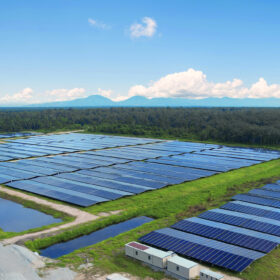Top News
Vending machine trial with chalcopyrite solar

Norway deploys 49 MW of solar in H1

PV-powered liquid air system yields hydrogen, heating, fresh water
pv magazine Webinar
Sign up for our free pv magazine newsletters
Media Kit 2025

Solar primed for expansion in Malaysia

System-level failures – the next frontier for safer battery storage
Portugal to hold energy storage auction before January 2026
Enphase launches fourth-gen energy system with new 7.08 kW battery
Surplus PV for electric delivery vehicles
Press Releases
Powering the AI Era Sustainably: From Net-Zero Vision to Real-World Delivery with Trinasolar’s Net-Zero Solution
JA Solar Establishes Global Benchmark with TÜV Rheinland’s First Certification for PV Cell Power Measurement Uncertainty
CPVT Yinchuan PV Module Low-Light Performance Verification: TOPCon Shows Up to 4.38% Higher Gain Than B
PHONO Among the First Chinese PV Brands to Achieve German DIBT Certification
Opinion & Analysis
Featured
Why strategy is key: Lessons from real-world benchmarks
Europe’s solar generation hit new heights during June heatwave
In a new weekly update for pv magazine, Solcast, a DNV company, reports that significant swathes of Europe saw much more solar irradiance than normal last month.
‘Leadership isn’t about being the loudest voice’
This week Women in Solar+ Europe gives voice to Jessica Klein, Head of Regulatory EU & Germany at RWE Renewables. She says working in solar it’s not just joining an industry, but also becoming part of a global shift toward a cleaner, smarter, more inclusive energy future. “Claim your space in that movement. And help lead the way,” she states.
Surplus solar panels offer timely solution for industry under pressure
Supply chain challenges, subsidies and tariff uncertainties are forcing the solar energy industry to find significant cost efficiencies. As older models of installed solar panels become harder to source, the growing second-life solar market helps industry find replacement panels and other equipment.
FOB China solar panel prices climb amid concerns about delinking with market fundamentals
In a new weekly update for pv magazine, OPIS, a Dow Jones company, provides a quick look at the main price trends in the global PV industry.
‘Small moments of awareness can create real change’
This week Women in Solar+ Europe gives voice to Jodie Brush, Communications & Public Affairs Manager at Verbund Green Power Iberia. She says that real progress happens when everyone is involved. “Gender equality isn’t just a women’s issue. Men must be invited to join the conversation, listening, learning, challenging their own assumptions, and becoming allies,” she states.
Markets & Policy
Featured
Map shows 43% of Iran’s land unsuitable for PV-powered water pumps
India could cut power costs to $50/MWh with solar-wind system by 2050
India could cut electricity costs to about $50/MWh by 2050 by transitioning to a fully wind- and solar-powered system with primarily day-night balancing, according to new modeling that includes generation, grid, and balancing costs – well below current fossil-based wholesale prices.
OX2 solar and storage project clears federal review in Australia
A 90 MW solar farm and four-hour battery energy storage system planned for the Richmond Valley in northern New South Wales has passed through the federal environmental approvals process in just 30 business days.
PV installers must act as US solar tax credit phase-out looms
Aurora Solar says most US homeowners are unaware of the urgency created by the One Big Beautiful Bill’s (OBBB) phase-out of the 30% solar tax credit, underscoring the need for installers to educate consumers, cut soft costs, and prioritize transparency.
Lyten to buy Northvolt assets with $200 million for BESS push in Europe
Lyten has raised an additional $200 million to accelerate its efforts to become a main player in Europe for its battery energy storage systems (BESS), following its earlier acquisition of a plant in Gdansk, Poland.
India’s MSEDCL tenders 2 GW/4 GWh of grid-connected battery storage
India’s Maharashtra State Electricity Distribution Co. Ltd. (MSEDCL) has issued a tender for 2 GW/4 GWh of battery energy storage systems (BESS) at sites connected to the intra-state grid. Developers will be selected to deploy the systems across MSEDCL-designated locations.
Installations
Featured
Mito Solar launches new range of colored modules for yachts, cars
PV-thermal energy with heat pumps, aquifer thermal storage in buildings
Researchers in the Netherlands have simulated a residential energy system combining PV, solar thermal, and PV-thermal panels with aquifer thermal energy storage and a heat pump, achieving a seasonal coefficient of performance of seven across five buildings.
Using Sudoku to improve power yield in PV systems under partial shading
Indian researchers have developed a Sudoku-based technique to reduce power losses in PV systems operating under partial shading. They claim the method increases energy efficiency and revenue generation more than conventional reconfiguration techniques.
TotalEnergies starts building 1 GW solar plant in southern Iraq
France’s TotalEnergies has broken ground on a 1 GW solar project in Iraq. The first 250 MW phase is due to come online before the end of this year.
Solar on the tracks
Swiss startup Sun-Ways inaugurated its railway PV project in April in Neuchatel, Switzerland, after more than two years of planning. Joseph Scuderi, founder of Sun-Ways, tells pv magazine that the pilot is attracting international attention.
Solitek launches anti-glare black bifacial solar modules
Lithuania’s Solitek has launched full-black 425 W bifacial solar modules with matte, satin-textured glass for glare-sensitive sites such as airports, road barriers, and buildings.
Technology
Featured
Perovskite rollout gathers pace
Gallium arsenide solar cells radiation-resilient for space applications
A group led by Cambridge University has developed an adhesive-free method of bonding ultra-thin gallium arsenide solar cells to borosilicate glass. The proposed technique is reportedly compatible with standard planar device processing.
High-temperature co-annealing step could cut TOPCon cell costs
Researchers at the Ecole Polytechnique Fédérale de Lausanne (EPFL) have proposed combining the two high-temperature steps used in producing tunnel oxide passivated contact (TOPCon) solar cells into a single co-annealing process. Initial results show promising outcomes in boron concentration, passivation quality, and contact resistivity.
Novel switched capacitor boosting inverter for PV usage
Researchers have designed a new switched-capacitor-based multilevel inverter topology with nine switches. They have tested it in simulations and in hardware-in-the-loop tests. Efficiency reached up to 96.5%.
Dual PV module cooling tech based on water, air
Scientists in Hungary have built an experimental rig that uses a 60 W polycrystalline solar panel with 152 holes drilled into its frame for air cooling, as well as high-conductivity copper alloy pipes and fins placed on its back for water cooling.
Organic cell based on additive-based coating solution achieves 16.27% efficiency
Scientists from the Korea Institute of Science and Technology (KIST) have used a dielectric additive in organic photovoltaic fabrication to produce uniform films in ambient humidity levels between 10% and 70%. The researchers said the approach improves process stability for organic solar cells.
Manufacturing
Featured
China’s PV output, profits fall in H1 despite record installations
CEA recommendations for mitigating glass breakage
Solar modules are getting bigger, thinner, and more powerful. But from Texas to Thailand, the same problem is appearing: broken glass. Not from hail or mishandling, but from cracks that spider from frame edges, splinter near clamps, and web across modules. In cases seen by Jörg Althaus, director of engineering and quality assurance at Clean Energy Associates (CEA), it starts with a few panels – then dozens, hundreds, even thousands.
Italian startup building power beaming tech for drones
SunCubes, a startup from Italy, is developing laser-based wireless power transfer technology to provide in-flight energy to drones for uninterrupted recharging. It has raised seed funding to finance a minimal viable product.
Improving vertical PV performance with adjustable reflectors
Researchers in Taiwan have developed an adjustable aluminum reflector system that boosts the performance of vertically mounted bifacial solar modules. The prototype delivered a 71.32% total power gain over a baseline system without reflectors.
Chinese PV Industry Brief: China passes 1.1 TW of solar despite June slowdown
China added 212.2 GW of new solar capacity in the first half of 2025, pushing total installed PV capacity past 1.1 TW, according to the National Energy Administration (NEA).
U.S. startup installs building-integrated, organic photovoltaic facade
Next Energy Technologies has completed the first installation of its transparent organic photovoltaic glass facade. The 9.3 m2 installation is located at its headquarters in Santa Barbara, California.
Energy Storage
Featured
UK needs to get “obsessed” with energy storage, says ESA founder
Iron-sodium battery to back up fire-prone community in California
The US Department of Energy has granted $4.1 million to Inlyte Energy to deploy grid-scale batteries in a microgrid in northern California.
New battery maker builds Czech factory with European software
Partners from Germany and Czechia are building a battery storage production line in eastern Czechia, integrating in-house control systems to improve cybersecurity and reduce reliance on Chinese infrastructure.
Sunotec, Sungrow partner on 2.4 GWh of battery storage in Europe
Sunotec says it will deploy Sungrow battery energy storage system (BESS) tech across co-located solar projects in Bulgaria and wider Europe.
DP Energy plans wind farm with 2,000 MWh battery in Australia
The Windy Plains Renewable Energy Park will deploy approximately 197 turbines for 1,400 MW of wind capacity alongside 500 MW/2,000 MWh of battery energy storage systems (BESS).
Design solar for storage now, or retrofit at a premium later
New analysis of retrofitting solar power plants with energy storage, accounting for the industry’s rapidly falling prices, suggests that prepping your solar projects today has a strong chance of being in your financial interest.



